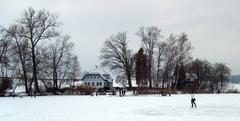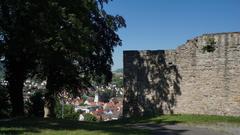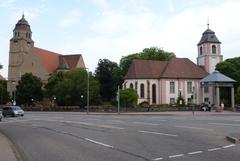Comprehensive Guide to Visiting Büchelberg and Pforzheim, Germany
Date: 25/07/2024
Introduction
Nestled in the enchanting Black Forest region of Germany, Büchelberg and Pforzheim offer a captivating blend of history, natural beauty, and cultural richness. Büchelberg, a tranquil nature reserve, is known for its rich historical backdrop and diverse flora and fauna. Pforzheim, often referred to as the ‘Golden City,’ boasts a storied past marked by its Roman origins and its significance as a hub for the jewelry and watchmaking industries. This comprehensive guide aims to provide prospective visitors with detailed insights into the historical sites, natural attractions, cultural heritage, and practical information for visiting these two remarkable destinations. Whether you are a history enthusiast, nature lover, or cultural explorer, Büchelberg and Pforzheim promise an enriching and memorable experience. For further details on the historical significance and attractions of these locations, explore sources such as Schwarzwaelder Bote and Tourism BW.
Table of Contents
- Introduction
- Discover the Historical Beauty of Büchelberg
- Explore Pforzheim
- Conclusion
Discover the Historical Beauty of Büchelberg
Historical Background
Büchelberg, designated as a nature reserve since 1939, is rich in history. Its strategic location, marked by the Altwürttembergische Landgraben (Old Württemberg Land Ditch) from the early 17th century, highlights its importance in regional boundary demarcations between Württemberg and Baden (Schwarzwaelder Bote). The nearby city of Pforzheim, known for its tragic WWII bombing, serves as a poignant reminder of the area’s turbulent past (Medium).
Natural Attractions
Büchelberg’s landscape, dominated by Muschelkalk (shell limestone), features dense forests, rolling hills, and diverse flora and fauna (Schwarzwaelder Bote). The nature reserve is home to rare orchids and wildflowers, and its hiking trails, maintained by the Schwarzwaldverein (Black Forest Association), cater to all levels of hikers. Popular routes offer stunning views and connect to nearby villages like Simmozheim and Monakam.
Traditional landscape management techniques are employed to preserve the area’s biodiversity. Sheep and goats graze the vegetation, maintaining open meadows and supporting local agricultural traditions (Schwarzwaelder Bote).
Cultural Insights
Büchelberg’s cultural heritage is shaped by its historical role as a borderland. Visitors can explore remnants of historical fortifications and learn about regional conflicts and trade (Schwarzwaelder Bote). Nearby Pforzheim, the “Golden City,” is renowned for its jewelry and watchmaking industries, adding another layer of cultural richness to your visit.
Practical Visitor Information
Visiting Hours and Tickets
Büchelberg nature reserve is open year-round. However, the best time to visit is during the spring and summer months when the flora is in full bloom. There is no entrance fee to explore the reserve, but guided tours may have associated costs. Check the official Büchelberg website for the latest updates on tours and special events.
Travel Tips
- Transportation: Büchelberg is accessible by car and public transport. The nearest major city, Pforzheim, is well-connected by train, and from there, local buses can take you to the reserve.
- Accommodation: There are several charming guesthouses and hotels in Pforzheim and surrounding villages. Booking in advance is recommended, especially during peak tourist seasons.
- What to Bring: Comfortable hiking shoes, a camera, and a picnic are must-haves for a day at Büchelberg. Don’t forget to bring water and sun protection, especially in the summer.
Nearby Attractions
- Pforzheim Jewelry Museum: Explore the rich history of jewelry and watchmaking in Pforzheim, just a short drive from Büchelberg.
- Monbachtal Gorge: A beautiful hiking spot with waterfalls and scenic views, perfect for nature enthusiasts.
- Simmozheim: A quaint village offering traditional Black Forest charm and hospitality.
FAQ
Q: Are there guided tours available in Büchelberg?
A: Yes, guided tours are available, offering in-depth historical and cultural insights. Check the official Büchelberg website for scheduling and pricing details.
Q: Is Büchelberg accessible for people with disabilities?
A: While the main trails are well-maintained, some areas may be challenging for those with mobility issues. It’s advisable to contact local authorities for specific accessibility information.
Q: What wildlife can I expect to see in Büchelberg?
A: The reserve is home to a variety of wildlife including deer, foxes, and numerous bird species. Keep an eye out for the rare orchids and wildflowers as well!
Explore Pforzheim
Historical Significance
Pforzheim, often referred to as the ‘Golden City,’ is an urban district in the state of Baden-Württemberg, Germany. Its history dates back to Roman times, with the city’s establishment around 90 AD. Pforzheim’s strategic location at the confluence of the Enz, Nagold, and Würm rivers made it a significant settlement throughout history. The city endured substantial destruction during World War II, with approximately 83% of its buildings destroyed in air raids, particularly the devastating raid on February 23, 1945 (Tourism BW).
Cultural and Industrial Heritage
Jewelry and Watchmaking Industry
Pforzheim is renowned for its jewelry and watchmaking industry, earning it the nickname ‘Golden City.’ The city’s transformation into a jewelry hub began in 1767 when Margrave Karl Friedrich of Baden founded the ‘Manufaktur für Schmuck und Uhren’ (Jewelry and Clock Manufacturer). This initiative attracted both German and foreign goldsmiths, establishing Pforzheim as a unique center for jewelry and design (Tourism BW).
The Pforzheim Jewellery Museum is a globally unique institution dedicated to the history of jewelry. It houses around 2,000 exhibits tracing 5,000 years of jewelry history, including antique, renaissance, and Art Nouveau treasures, as well as modern jewelry art from the 1960s to the present day (Tourism BW).
Technological Advancements
Pforzheim’s industrial heritage is not limited to jewelry. The city has embraced high technology and design, making it a hub for innovation. The Technical Museum of Pforzheim’s Jewellery and Watchmaking Industries showcases the technological advancements in the manufacture of clocks and jewelry. Visitors can see many of the machines in action, providing a glimpse into the intricate processes involved in these crafts (Tourism BW).
Attractions
St. Michael’s Schlosskirche
One of Pforzheim’s most famous buildings is St. Michael’s Schlosskirche, known for its impressive Romanesque westwork. This church is not only the burial site of the Margraves of Baden but also the final resting place of Grand-Duchess Stephanie, Napoleon’s adoptive daughter. The church’s historical and architectural significance makes it a must-visit landmark (Tourism BW).
Visiting Hours: Monday to Saturday - 9:00 AM - 6:00 PM; Sunday - 12:00 PM - 6:00 PM
Tickets: Free entry
Schmuckwelten (Jewellery World)
The ‘Schmuckwelten’ (Jewellery World) is a fascinating theme park dedicated to the world of gold and precious stones. It features numerous attractions, including the star lift and the golden wall, as well as a collection of 5,000 magnificent minerals from around the world. This attraction offers an immersive experience into the world of jewelry and is a highlight for visitors interested in the craft (Tourism BW).
Visiting Hours: Monday to Friday - 10:00 AM - 6:00 PM; Saturday - 10:00 AM - 4:00 PM
Tickets: Adults - €8, Children (6-14) - €4, Family Ticket - €20
Gasometer Pforzheim
The Gasometer Pforzheim is a unique attraction featuring the ‘Great Barrier Reef - Coral Reef Wonder World’ exhibition. This panoramic display offers a breathtaking view of the underwater world, providing an educational and visually stunning experience for visitors of all ages (Tourism BW).
Visiting Hours: Daily - 10:00 AM - 5:00 PM
Tickets: Adults - €12, Children (6-14) - €6, Family Ticket - €30
Reuchlinhaus Arts Center
The Reuchlinhaus Arts Center, located in Pforzheim’s municipal park, serves as a cultural forum and memorial to Johannes Reuchlin, the city’s most celebrated humanist. The center hosts various cultural events and exhibitions, making it a vibrant part of Pforzheim’s cultural landscape (My German City).
Visiting Hours: Tuesday to Sunday - 11:00 AM - 6:00 PM
Tickets: Adults - €5, Children (6-14) - €2.50
Pforzheim Wildlife Park
For nature and animal lovers, the Pforzheim Wildlife Park on the southern outskirts of the city is a popular destination. Open year-round, the park features a variety of animals, including rare mammals and birds, making it a favorite spot for families and children (My German City).
Visiting Hours: Daily - 9:00 AM - 6:00 PM
Tickets: Free entry
Enzauen Park
Enzauen Park is a well-loved leisure area in Pforzheim, offering a wide range of recreational and sporting activities. It is an ideal spot for relaxation and people-watching, providing a serene environment amidst the city’s hustle and bustle (My German City).
Visiting Hours: Open 24 hours
Tickets: Free entry
Visitor Tips
Getting There
Pforzheim is well-connected by public transport, with regular train services from major cities like Stuttgart and Karlsruhe. The city’s central location makes it an accessible gateway to the Black Forest, ideal for cyclists and hikers looking to explore the region (Tourism BW).
Accommodation
Visitors to Pforzheim can choose from a range of accommodation options, including hotels, guesthouses, and apartments. The city offers something for every budget, ensuring a comfortable stay for all types of travelers (ViaMichelin).
Best Time to Visit
The best time to visit Pforzheim is during the spring and summer months when the weather is pleasant, and outdoor activities are in full swing. The city’s parks and gardens are particularly beautiful during this time, offering a picturesque setting for visitors (My German City).
Local Cuisine
Pforzheim offers a variety of dining options, from traditional German cuisine to international dishes. Visitors should not miss the opportunity to try local specialties, such as Black Forest ham and cherry cake, which are popular in the region (Tourism BW).
FAQ
Q: What are the visiting hours for Pforzheim’s museums?
A: Most museums in Pforzheim operate from 10:00 AM to 5:00 PM, with variations on weekends. It is recommended to check the specific museum’s website for exact visiting hours.
Q: Is Pforzheim accessible for disabled visitors?
A: Yes, many of Pforzheim’s attractions are accessible for disabled visitors. It is best to check individual attraction websites for detailed accessibility information.
Q: What are the ticket prices for Pforzheim’s attractions?
A: Ticket prices vary by attraction. For example, the Schmuckwelten charges €8 for adults, while the Gasometer Pforzheim charges €12. Some attractions, like the Pforzheim Wildlife Park, offer free entry.
Conclusion
Büchelberg and Pforzheim offer an unparalleled blend of natural beauty, historical depth, and cultural richness. Büchelberg stands out as a serene nature reserve, perfect for hiking and exploring its diverse flora and fauna. In contrast, Pforzheim, with its rich historical tapestry and renowned jewelry and watchmaking industry, provides a fascinating glimpse into both ancient and modern times. Visitors can immerse themselves in the historical fortifications of Büchelberg or marvel at the intricate craftsmanship showcased at the Pforzheim Jewellery Museum. Both destinations are accessible and offer a range of accommodations, ensuring a comfortable and enriching visit. For an unforgettable experience, plan your trip to Büchelberg and Pforzheim today and uncover the many treasures these hidden gems have to offer. For real-time updates and interactive maps, consider downloading the Audiala mobile app. Stay connected for more travel inspiration and tips by following our social media channels (Schwarzwaelder Bote, Tourism BW).





